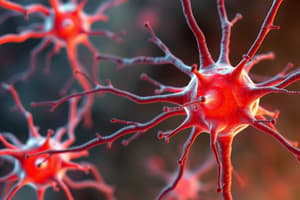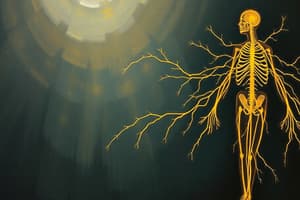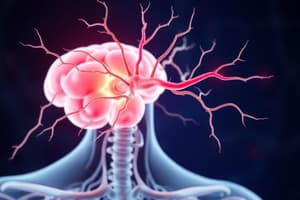Podcast
Questions and Answers
What neurotransmitter is typically released by postganglionic sympathetic neurons?
What neurotransmitter is typically released by postganglionic sympathetic neurons?
- GABA
- Norepinephrine (correct)
- Dopamine
- Serotonin
Which statement accurately describes the sympathetic division of the autonomic nervous system?
Which statement accurately describes the sympathetic division of the autonomic nervous system?
- It primarily promotes 'rest and digest' functions.
- It typically has short preganglionic fibers and long postganglionic fibers. (correct)
- It mainly innervates skeletal muscles directly.
- It is referred to as the craniosacral division.
Which of the following best describes the dual innervation of body organs by the autonomic nervous system?
Which of the following best describes the dual innervation of body organs by the autonomic nervous system?
- Only the sympathetic division is active at any given time.
- Dual innervation does not occur in most organs.
- One division stimulates while the other inhibits the organ function. (correct)
- Both divisions cause the same effects on the organs.
What structure do the autonomic motor neurons synapse in before reaching their effectors?
What structure do the autonomic motor neurons synapse in before reaching their effectors?
What is the primary function of the parasympathetic division of the autonomic nervous system?
What is the primary function of the parasympathetic division of the autonomic nervous system?
Which type of fibers emerge from the brainstem according to the parasympathetic division?
Which type of fibers emerge from the brainstem according to the parasympathetic division?
In the autonomic nervous system, what effect does increased activity in one division have on the other?
In the autonomic nervous system, what effect does increased activity in one division have on the other?
How do preganglionic neurons of the autonomic nervous system communicate with postganglionic neurons?
How do preganglionic neurons of the autonomic nervous system communicate with postganglionic neurons?
What is the primary activity regulated by the hypothalamus in the autonomic nervous system?
What is the primary activity regulated by the hypothalamus in the autonomic nervous system?
Which of the following situations primarily stimulates the sympathetic division?
Which of the following situations primarily stimulates the sympathetic division?
During the fight-or-flight response, which of the following changes occurs in the body?
During the fight-or-flight response, which of the following changes occurs in the body?
What acronym is used to remember the five main responses of the parasympathetic division?
What acronym is used to remember the five main responses of the parasympathetic division?
What happens to digestive activities during activation of the parasympathetic division?
What happens to digestive activities during activation of the parasympathetic division?
Which of the following is a benefit of engaging in regular, vigorous exercise for stress management?
Which of the following is a benefit of engaging in regular, vigorous exercise for stress management?
Which of the following represents a decrease in the body’s functions during parasympathetic activation?
Which of the following represents a decrease in the body’s functions during parasympathetic activation?
Which organs experience constriction of blood vessels during the fight-or-flight response?
Which organs experience constriction of blood vessels during the fight-or-flight response?
Flashcards
Sympathetic Nervous System
Sympathetic Nervous System
Part of the autonomic nervous system, responsible for the "fight or flight" response.
Parasympathetic Nervous System
Parasympathetic Nervous System
Part of the autonomic nervous system responsible for the "rest and digest" response.
Autonomic Nervous System
Autonomic Nervous System
Part of the nervous system that regulates involuntary bodily processes.
Ganglion (in ANS)
Ganglion (in ANS)
Signup and view all the flashcards
Dual Innervation
Dual Innervation
Signup and view all the flashcards
Sympathetic Fibers Origin
Sympathetic Fibers Origin
Signup and view all the flashcards
Parasympathetic Fibers Origin
Parasympathetic Fibers Origin
Signup and view all the flashcards
Acetylcholine (ACh) vs. Norepinephrine (NE)
Acetylcholine (ACh) vs. Norepinephrine (NE)
Signup and view all the flashcards
Sympathetic vs. Parasympathetic Tone
Sympathetic vs. Parasympathetic Tone
Signup and view all the flashcards
Fight-or-Flight Response
Fight-or-Flight Response
Signup and view all the flashcards
Fight-or-Flight Response: Pupils
Fight-or-Flight Response: Pupils
Signup and view all the flashcards
Parasympathetic Activities
Parasympathetic Activities
Signup and view all the flashcards
SLUDD Responses (Parasympathetic)
SLUDD Responses (Parasympathetic)
Signup and view all the flashcards
Exercise & Stress Reduction
Exercise & Stress Reduction
Signup and view all the flashcards
Decreases of Parasympathetic System
Decreases of Parasympathetic System
Signup and view all the flashcards
Sympathetic Stimuli
Sympathetic Stimuli
Signup and view all the flashcards
Study Notes
The Nervous System - Part 3
- The autonomic nervous system (ANS) regulates smooth muscle, cardiac muscle, and certain glands.
- The ANS usually functions without conscious control; however, brain regions like the hypothalamus and brain stem regulate it.
- Somatic motor neurons connect the central nervous system (CNS) directly to skeletal muscle.
- Somatic motor pathways consist of one neuron.
- Autonomic pathways involve two neurons: a preganglionic neuron and a postganglionic neuron that synapse in an autonomic ganglion.
- The ANS has two divisions: sympathetic and parasympathetic.
- Most organs receive dual innervation from both systems; one division usually stimulates, while the other inhibits.
- Somatic motor neurons release acetylcholine (ACh).
- Autonomic motor neurons release either acetylcholine (ACh) or norepinephrine (NE).
- Pre-ganglionic neurons release ACh.
- Postganglionic neurons can release either norepinephrine (NE) or acetylcholine (ACh) depending on the division of the ANS.
- Sympathetic division neurons leave the CNS at thoracic and lumbar levels of the spinal cord.
- Parasympathetic division neurons leave the CNS at the brainstem and sacral levels of the spinal cord.
- Sympathetic is often referred to as the "fight or flight" response.
- Parasympathetic is often referred to as the "rest and digest" response.
- The fight-or-flight response involves pupil dilation, increased heart rate and blood pressure, airway dilation, and constriction of nonessential organ blood vessels.
- The rest-and-digest response includes slowing of digestion, urine production, and digestive activities, blood vessel dilation of organs involved in exercise, and relaxation of the urinary bladder.
- The balance between sympathetic and parasympathetic activity is known as "tone", regulated by the hypothalamus.
- The hypothalamus typically turns up sympathetic tone while simultaneously turning down parasympathetic tone.
- The SLUDD responses (Salivation, Lacrimation, Urination, Digestion, Defecation) are primarily parasympathetic responses.
- The parasympathetic division decreases heart rate, airway diameter, and pupil diameter.
- Engaging in regular exercise can help manage stress by releasing endorphins, increasing dopamine levels, and increasing other mood-boosting molecules like serotonin and oxytocin.
Studying That Suits You
Use AI to generate personalized quizzes and flashcards to suit your learning preferences.




